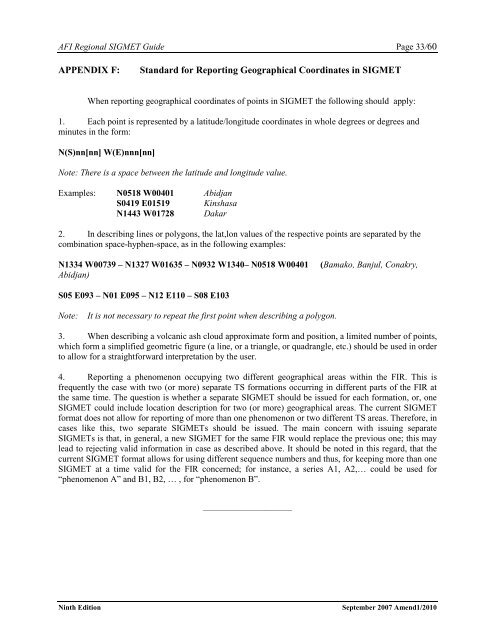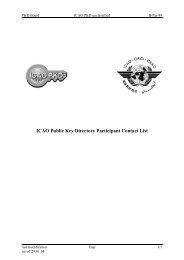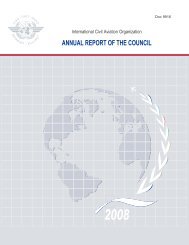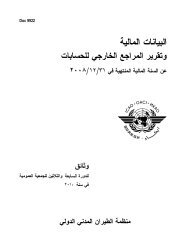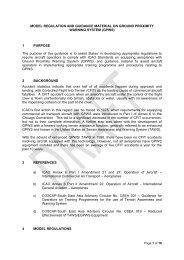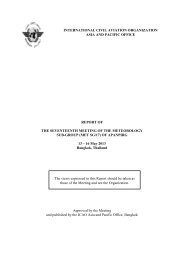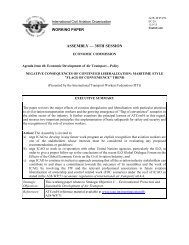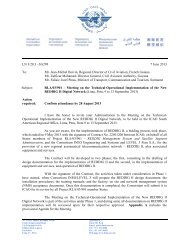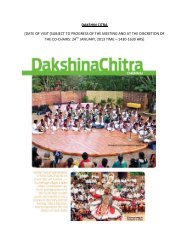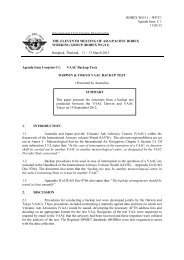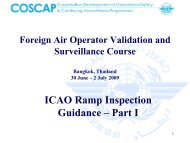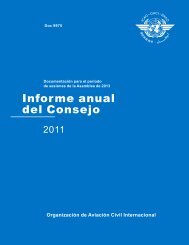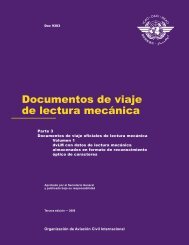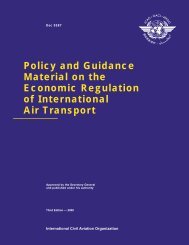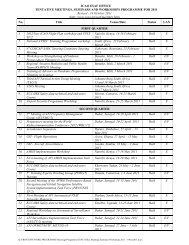afi met bulletins exchange (ambex) handbook - ICAO
afi met bulletins exchange (ambex) handbook - ICAO
afi met bulletins exchange (ambex) handbook - ICAO
You also want an ePaper? Increase the reach of your titles
YUMPU automatically turns print PDFs into web optimized ePapers that Google loves.
AFI Regional SIGMET Guide Page 33/60<br />
APPENDIX F: Standard for Reporting Geographical Coordinates in SIGMET<br />
When reporting geographical coordinates of points in SIGMET the following should apply:<br />
1. Each point is represented by a latitude/longitude coordinates in whole degrees or degrees and<br />
minutes in the form:<br />
N(S)nn[nn] W(E)nnn[nn]<br />
Note: There is a space between the latitude and longitude value.<br />
Examples: N0518 W00401 Abidjan<br />
S0419 E01519 Kinshasa<br />
N1443 W01728 Dakar<br />
2. In describing lines or polygons, the lat,lon values of the respective points are separated by the<br />
combination space-hyphen-space, as in the following examples:<br />
N1334 W00739 – N1327 W01635 – N0932 W1340– N0518 W00401 (Bamako, Banjul, Conakry,<br />
Abidjan)<br />
S05 E093 – N01 E095 – N12 E110 – S08 E103<br />
Note: It is not necessary to repeat the first point when describing a polygon.<br />
3. When describing a volcanic ash cloud approximate form and position, a limited number of points,<br />
which form a simplified geo<strong>met</strong>ric figure (a line, or a triangle, or quadrangle, etc.) should be used in order<br />
to allow for a straightforward interpretation by the user.<br />
4. Reporting a phenomenon occupying two different geographical areas within the FIR. This is<br />
frequently the case with two (or more) separate TS formations occurring in different parts of the FIR at<br />
the same time. The question is whether a separate SIGMET should be issued for each formation, or, one<br />
SIGMET could include location description for two (or more) geographical areas. The current SIGMET<br />
format does not allow for reporting of more than one phenomenon or two different TS areas. Therefore, in<br />
cases like this, two separate SIGMETs should be issued. The main concern with issuing separate<br />
SIGMETs is that, in general, a new SIGMET for the same FIR would replace the previous one; this may<br />
lead to rejecting valid information in case as described above. It should be noted in this regard, that the<br />
current SIGMET format allows for using different sequence numbers and thus, for keeping more than one<br />
SIGMET at a time valid for the FIR concerned; for instance, a series A1, A2,… could be used for<br />
“phenomenon A” and B1, B2, … , for “phenomenon B”.<br />
——————————<br />
Ninth Edition September 2007 Amend1/2010


